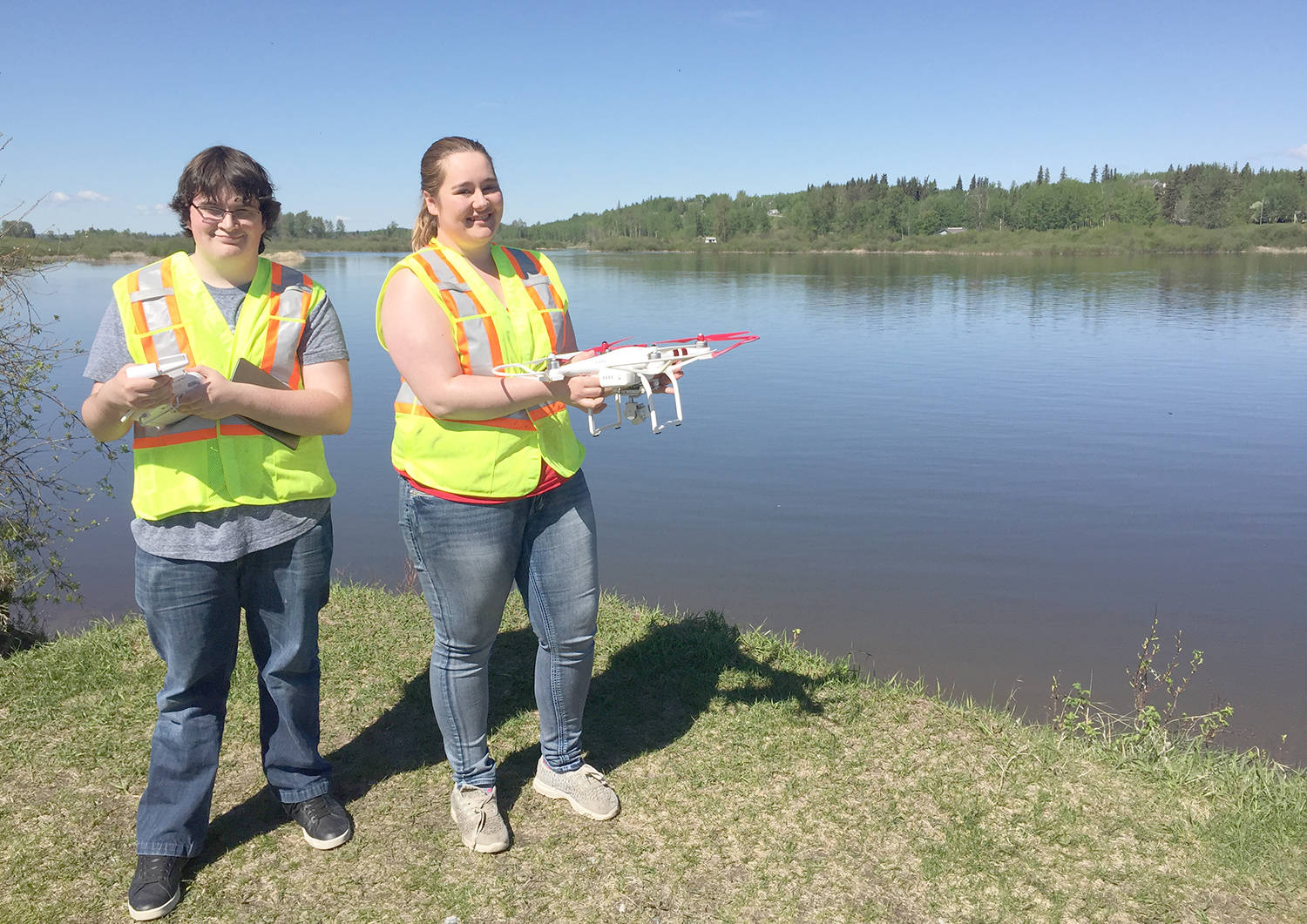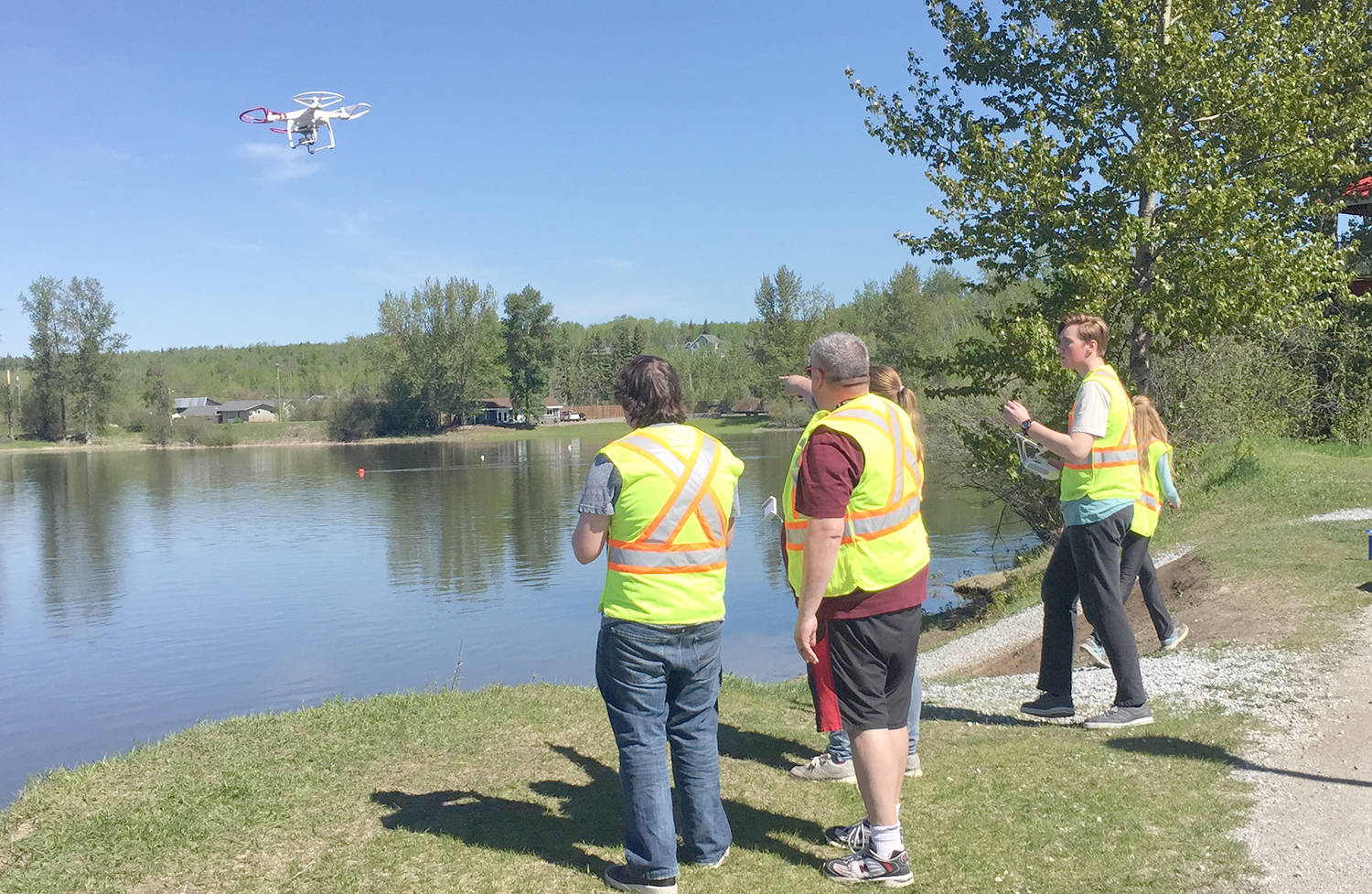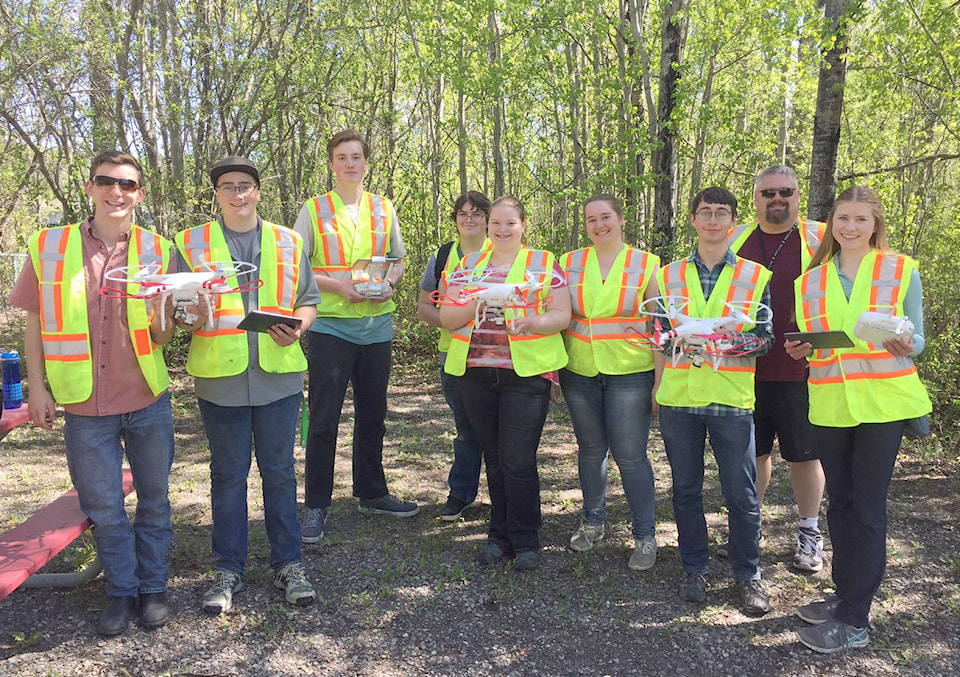Since February this year Fort St. James Secondary School has been “piloting” a ‘Drones, Unmanned Aerial Vehicle (UAV) and ground pilot’ grade 12 elective course. And it’s a flying success, of course! Mr. Andrew Vogelsang’s student’s were at the Nechako in Vanderhoof last week testing out their drone aviation skills and recording aerial footage of the river from drone cameras.
In this exercise the drones are being used to film sturgeon in the river. “They’re particularly looking for sturgeon exhibiting spawning behaviour” says Michelle Roberge Coordinator of the Working Group for the Nechako White Sturgeon Recovery Initiative (NWSRI).
“Spawning behaviour in the Nechako has only been recorded on video once before from a helicopter. Hopefully this new drone technology will prove successful today. Thanks to teacher Mr. Vogelsang and this crew of enthusiastic students for coming and participating in the sturgeon recovery initiative” says Michelle.
The video footage will be studied and shared with the Nechako White Sturgeon Conservation Centre because it might contain valuable information about presence of sturgeon, location of egg deposits and whether or not the egg mats are doing their job.
“We’re trying to find out where the sturgeon are spawning so we’re flying up and down the banks and over by the buoys. The mats are attached to the buoys and are there to catch the eggs” says one of the students.
“The mats are there for a reason. We want to see how many eggs there are, and how much of them are fertilised” says Wayne Salewski, Chair of the NWSRI Working Group.
This is an excellent example of citizen-science in action. With the water clarity being fair the data the students are gathering should be useful, but is just a bonus really. Because the fun hands-on learning experience is actually all about the actual flying of the drones. They have to navigate the drones over the water, up and down the banks, around vegetation and over tree tops, steering clear of boats and other drones, there are four in total, all flying over the area at the same time.
There are four drones so the eight students work in pairs with one piloting the drone and the other looking at a tablet screen at the video recording streamed directly from the camera.
“We let Transport Canada know that we’re flying. Technically we’re okay because we’re far enough away from buildings, people and cars etc. but still what we’re doing right now does fits under the umbrella of flying aircraft so the students are learning the habits of responsible flying.” says Mr. Vogelsang.
“Drones are here to stay” he continues, “Drones are becoming very useful tools and they are much more affordable than alternatives like flying manned aircraft.”
“In this class I have been teaching there are practical legal and safety considerations when using drones. The students have learnt quite a bit because comparing what they wanted to do with them at the beginning of the semester and where they are now. They realise they can’t do those things. They started off wanting to film themselves mountain biking on a follow-me mode, for example, but that’s too tricky and dangerous because of trees on the trails.
“Teaching basic responsibility around it is the first step, because drones are relatively cheap and some are virtually disposable so it’s no big deal if you wreck it. What I fear, as drones become more and more popular, is people are just going to be stupid with them because its currently unregulated and there’s no real consequence to crashing it; they’re replaceable.
Transport Canada is actually working on formulating regulations on drone aviation. What I’ve taught my students is aviation basics, that there are certain aerodromes you’re allowed to fly in. We are operating the drones in a ‘Class G’ aerodrome, in other words it’s ‘open’, and we’ve got a flight permit for flying here and behind the school as well.”
There’s several other things to consider when flying the drones and that includes battery life. There’s an alarm that will go off to warn that the battery is low. “You only get a 23 minute window on a full battery, and its worse when its cold” says Mr. Vogelsang.
There’s the occasional technological unpredictability to watch out for as well. One of the drones out over the middle of the water gave the signal that it ‘decided’ it was in a no fly zone and about to initiate an automatic landing sequence. That was a bit of a surprise but no harm no foul because our student pilot managed to swiftly bring the offending drone back to shore and a safe landing for a quick reset.
Deliberate take-off and landing the drone on a nearby picnic table (shown in one of the photo’s) was smart thinking after another ‘live and learn’ situation which had some consequences. Mr. Vogelsang explained that a drone not only sounds like a real little helicopter it behaves like one too.
“We landed a drone on the gravel parking lot behind the school earlier on in the semester and the vortex it created actually sucked a pebble and it shattered one of the blades. But fortunately we have spare parts and they are not expensive. We can source them from a whole bunch of companies, but we usually just get it on amazon.ca. The only thing to watch out for is shipping charges.”
“Isn’t that cool?” is Wayne Salewski’s rhetorical question as he watches the students fly the drones determinantly over the water.” We’re doing stream restoration on all the streams that feed into the Nechako river here. In days of old we would put people on the ground to gather that information. Now we can actually use a drone” he says. Having drones do the job increases efficiency and the possibilities are endless. It completely changes the game “It’s unreal” says Wayne.
“We see tons of applications here and so at the hatchery what we’re doing by partnering with the school district is offer the students exposure to opportunities like this.” He talks about the way community engagement and stewardship education have a role to play in conservation efforts.
“Citizen science has become more and more important to the whole process because [this added layer of information gathering] is affordable and its doable and its the community having eyes everywhere” to help capture information about the sturgeon and those observations fed back to the hatchery then supports the team of biologists in their work.
A NWRI boat approaches with biologists using radio antennae to track tagged sturgeon telemetry. The drones lift up out of the way, it looks completely synchronised. “Nicely done.” says Mr. Vogelsang to his students.
It’s not the sound of lawnmowers filling the air this summer day it’s the sound of drones.


